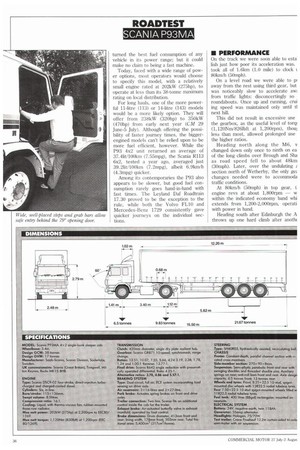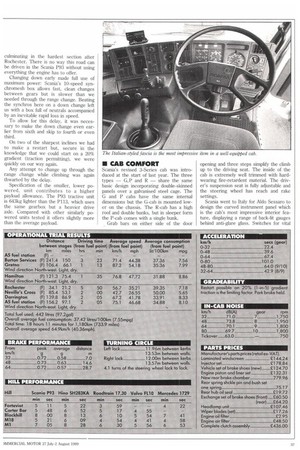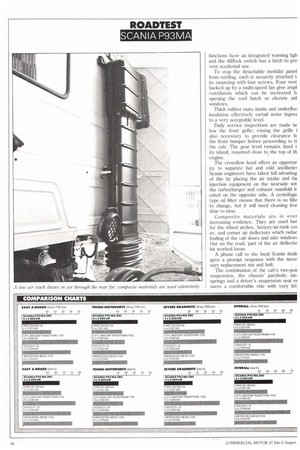• Fuel economy is a major performance criterion, and over
Page 35

Page 36

Page 37

Page 38

Page 39

If you've noticed an error in this article please click here to report it so we can fix it.
a long period commercial vehicle engineers have been successful in achieving an improvement of about 0.5% a year. Despite its dirty reputation, the diesel engine produces an efficiency of some 44%: substantially better than any other type of automotive engine.
New legislation governing exhaust emissions will inevitably slow this steady rate of progress. An unfortunate aspect of the diesel engine's efficiency is that it relies on generating high pressures and high temperatures within the combustion chamber, and this has been found incompatible with the reduction of nitrogen oxide exhaust emissions.
One way of improving the situation is to cool the air intake. Typically, an ambient air temperature of 25°C increases to 150°C after it passes through the turbocharger; but using an air-to-air charge cooler can reduce this to around 40°C.
To meet ECE and American emission requirements Scania has already developed a version of its 11-litre engine to the point where nitrogen oxide emissions have been halved. Its pedigree can be traced back about 30 years to when it was introduced with the assistance of Leyland injection and cooling technology.
The 8.5-litre engine, introduced only five years ago, benefits from a much higher level of technology and should find it much easier to meet tough emission limits. The P93 has just such a power unit, and over CM'S Scottish route it re* turned the best fuel consumption of any vehicle in its power range; but it could make no claim to being a fast machine.
Today, faced with a wide range of power options, most operators would choose to specify this model, with a relatively small engine rated at 202kW (275hp), to operate at less than its 38-tonne maximum rating on local distribution.
For long hauls, one of the more powerful 11-litre (113) or 14-litre (143) models would be a more likely option. They will offer from 238kW (320hp) to 350kW (470hp) from early next year (CM 29 June-5 July). Although offering the possibility of faster journey times, the biggerengined models can't be relied upon to be more fuel efficient, however. While the P93 4x2 unit returned an average of 37.41it/100km (7.55mpg), the Scania R113 6x2, tested a year ago, averaged just 39.21it/100km (7.2mpg), albeit 6.91(m/h (4.3mpg) quicker.
Among its contemporaries the P93 also appears to be slower, but good fuel consumption rarely goes hand-in-hand with fast times. The Leyland LW Roadtrain 17.30 proved to be the exception to the rule, while both the Volvo FL10 and Mercedes-Benz 1729 consistently gave quicker journeys on the individual sections.
• PERFORMANCE
On the track we were soon able to esta' lish just how poor its acceleration was. took all of 1.6km (1.0 mile) to clock I 80km/h (50mph).
On a level road we were able to pi away from the rest using third gear, but was noticeably slow to accelerate aw from traffic lights: disconcertingly so roundabouts. Once up and running, crui ing speed was maintained only until tl next hill.
This did not result in excessive use the gearbox, as the useful level of torqi (1,120Nm/8261bit at 1,200rpm), thou less than most, allowed prolonged use the higher ratios.
Heading north along the M6, v changed down only once to ninth on ea of the long climbs over Brough and Sha as road speed fell to about 48km (30mph). Later, over the undulating section north of Wetherby, the only gei changes needed were to accommoda traffic conditions.
At 80kria/h (50mph) in top gear, t engine revs at about 1,800rpm — w within the indicated economy band whi extends from 1,200-2,000rpm, operati with power in hand.
Heading south after Edinburgh the A throws up one hard climb after anottx culminating in the hardest section after Rochester. There is no way this road can be driven in the Scalia P93 without using everything the engine has to offer.
Changing down early made full use of maximum power: Scania's 10-speed synchromesh box allows fast, clean changes between gears but is slower than we needed through the range change. Beating the synchros here on a down change left us with a box full of neutrals accompanied by an inevitable rapid loss in speed.
To allow for this delay, it was necessary to make the down change even earlier from sixth and skip to fourth or even third.
On two of the sharpest inclines we had to make a restart but, secure in the knowledge that we could start on a 20% gradient (traction permitting), we were quickly on our way again.
Any attempt to change up through the range change while climbing was again thwarted by the delay.
Specification of the smaller, lower powered, unit contributes to a higher payload allowance. The P93 tractive unit is 643kg lighter than the P113, which uses the same gearbox but a heavier drive axle. Compared with other similarly powered units tested it offers slightly more than the average payload.
• CAB COMFORT
Scania's revised 3-Series cab was introduced at the start of last year. The three types G,P and R share the same basic design incorporating double-skinned panels over a galvanised steel cage. The G and P cabs have the same internal dimensions but the G-cab is mounted lower on the chassis. The R-cab has a high roof and double bunks, but in sleeper form the P-cab comes with a single bunk.
Grab bars on either side of the door opening and three steps simplify the climb up to the driving seat. The inside of the cab is extremely well trimmed with hardwearing fire-retardent material. The driver's suspension seat is fully adjustable and the steering wheel has reach and rake settings.
Scania went to Italy for Aldo Sessaro to design the curved instrument panel which is the cab's most impressive interior feature, displaying a range of back-lit gauges behind anti-glare glass. Switches for vital functions have an integrated warning ligh and the difflock switch has a latch to pre vent accidental use.
To stop the detachable modular panel from rattling, each is securely attached t its mounting with four screws. Four vent backed up by a multi-speed fan give ampl, ventilation which can be increased b opening the roof hatch or electric sid windows,
Thick rubber mats inside and underfloa insulation effectively curtail noise ingres to a very acceptable level.
Daily service inspections are made be low the front grille; raising the grille i also necessary to provide clearance fa the front bumper before proceeding to ti the cab. The gear level remains fixed t its island, mounted close to the top of th engine.
The crossflow head offers an opportur ity to separate hot and cold ancillaries Scania engineers have taken full advantag of this by placing the air intake and fut injection equipment on the nearside wit the turbocharger and exhaust manifold lc cated on the opposite side. A centrifuga type oil filter means that there is no flute to change, but it will need cleaning fror time to time.
Composite materials are in ever increasing evidence. They are used her for the wheel arches, battery/air-tank cos er, and corner air deflectors which reduc fouling of the cab doors and side window: Out on the road, part of the air deflectio kit worked loose.
A phone call to the local Scania dealt gave a prompt response with the nece sary replacement nut and bolt.
The combination of the cab's two-poil suspension, the chassis' parabolic ste springs and a driver's suspension seat ei stires a comfortable ride with very litt roll, Light power steering and a light clutch pedal minimised driver effort.
• BRAKING
A stubby park brake, operating on both axles, is mounted low down on the centre of the fascia next to a trailer brake lever. This is reminisent of the "dead man" control which disappeared from most British trucks 20 years ago. Owner-operators moving other people's trailers may like the idea of using their brakes to check the speed of the vehicle and reduce lining wear of the tractive unit.
Under maximum application on the test track, the drive axle wheels could be made to lock while those of the front axle continued to rotate. In this potentially dangerous situation the vehicle came to rest in a straight line without incident, but to he sure of avoiding a jack-knife the braking bias needs to be on the front axle if the wheels are going to lock up. The rationale behind this is that if the front brakes lock first the vehicle stays in a straight line, making it a simple matter to lift off the brake pedal to regain steering control. If the drive axle locks first, the tractive unit can rotate at the slightest provacation. Even if the brakes are released in time to prevent the vehicle folding completely the unit will be out of line, making it more difficult to regain directional control.
With the test vehicle fully laden full air pressure was available to front and rear brakes so we must assume that braking distribution is incorrect. Last year we experienced a similar problem with the R113 6x2. Then Scania's engineer suggested that smaller wheel cylinders for the drive axle would correct the situation.
The cab came equipped with Scania's full aerodynamic kit which includes rear fins to close the gap with the trailer. Using all of the adjustment available we moved the Jost sliding fifth wheel forward as far as possible. The offside fin is louvered to match the air intake stack.
• SUMMARY
The P93MA is Scania's lowest powered 38-tonne tractive unit, but its specification is a match for the more expensive and more powerful models in the range. Its smaller engine contributes to a good payload, giving a relatively low fuel consumption but understandably accompanied by slow journey times.
The vehicle's one real failing showed up during the braking tests.
Priced at a basic 243,000 without the many extras included on the test vehicle, it ranges between four and 12% more expensive than comparable models in a similar power bracket. Some of those will be offered at substantial discounts, and Scania says it is opposed to following suit.
• by Bill Brock




































































































































